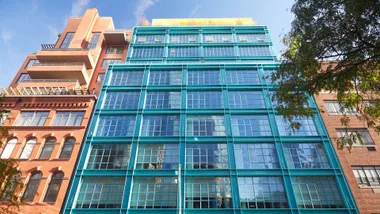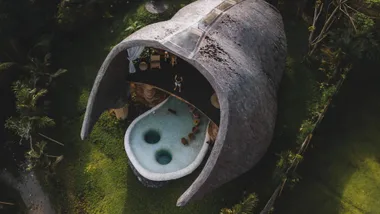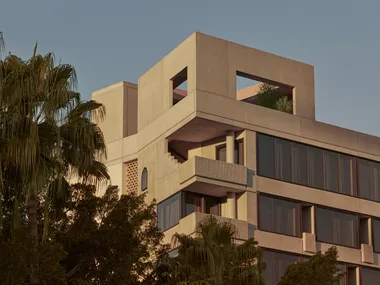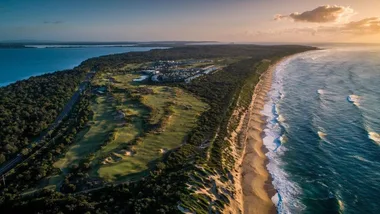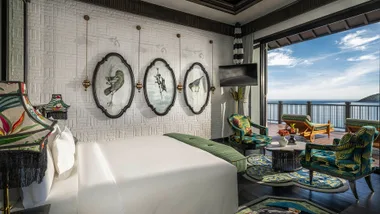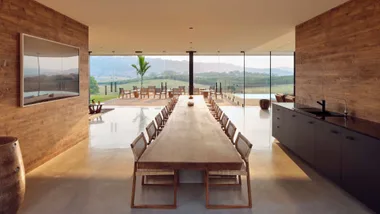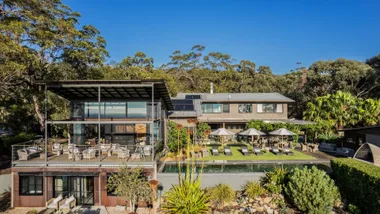ONLINE EXCLUSIVE
Check out our photo gallery for more awe-inspiring images from our South African safari.
THE FINE PRINT
**GETTING THERE
**Qantas operates six direct flights per week between Sydney and Johannesburg, and daily codeshare services between Perth and Johannesburg. Fares start at $1499.
STAY
Samara Private Game Reserve is in the Great Karoo National Park and has three lodge suites, three cottages, plus a separate manor house and mountain retreat. Lodge suites from $530 per person, per night, including meals, drinks and game drives. +27 049 891 0558.
Royal Legend Safari Lodge & Spa offers 10 chalets and entertaining boma dinners. Royal suites from $345 per person, per night, including full board and two game drives.+27 012 470 5300.
Royal Malewane‘s stellar accommodation and service, gourmet dining, five-star spa and offer of a private chef, butler and guide show why it’s the A-list’s choice. Double suites from $1430 per person, per night, fully inclusive. +27 015 793 0150.
Located on the boundary of the Kruger National Park and run by luxury adventure travel operator &Beyond, these 20 cottages and one Safari Suite are decked out in colonial style, with floral-print sofas, roaring fires and the odd wall-mounted buffalo head. Cottages from $445 per person, per night, fully inclusive. +27 011 809 4300.
This small but stylish sister property to Ngala Safari Lodge comprises six ensuite safari tents with air-conditioning and all mod cons. The stone outdoor (hot) showers are a highlight. Tented suites from $595 per person, per night, fully inclusive. +27 011 809 4300.
In the Eastern Cape, when rain falls and the sun shines, they call it a monkey’s wedding. On the drive from Port Elizabeth into the Karoo, we’re yet to sight any wildlife, but celebratory rainbows are arcing over the landscape as squalls buffet the van bouncing over the black-top.
The rain-smudged vista of scrubby plain and bleak hills unfolding through the windows is not the South Africa of the tourist brochures, but it holds a spare beauty of its own, unexpected as the optimism that you seem to find everywhere in this contradictory country.
Like the lone vineyard worker in the hills outside Cape Town, singing operatically into the winter wind as he prunes the vines. Or our driver in Johannesburg, who turns to face us when we stop at traffic lights in gritty downtown and, ignoring the rolling-eyed panhandlers rattling their beakers at the tinted windows of our glossy 4WD, smiles and says, “South Africa will be the most beautiful country in the world – don’t you agree?”
If beauty is judged by ethnic and geographical riches, then South Africa is lovely indeed. This most tribal of countries – a fact exploited by past powers to ruinous effect – boasts 11 languages and ranks third in the world in terms of biological diversity, its topography running from the temperate forest of the Western Cape to the towering dunes of the Kalahari Desert.
The Great Karoo, through which we are travelling, a semi-arid expanse of 400,000 square kilometres stretching inland from the Cape, was once home to the indigenous Khoisan people and unimaginably vast herds of game. Both were decimated by wagon-borne settlers sustained by the Bible and biltong – the national version of jerky, made from beef or game.
Here in the late 1990s, some 280km north of Port Elizabeth, Sarah and Mark Tompkins bought up 11 farms that amounted to 28,000 hectares of land degraded by sheep and goat grazing. Standing among the run-down buildings and scrappy vegetation, they imagined a safari lodge and private game reserve that would reintroduce wildlife such as springbok, cheetah, zebra and giraffe. Today, Samara Private Game Reserve is a splendidly isolated realisation of that dream (the nearest town is Graaff-Reinet, about 55km away), complete with a converted farmhouse housing three luxury suites, three cottages, a mountain retreat and a manor house.
Set on the plains of Camdeboo, made famous by the 19th-century Cape Frontier Wars, Samara is a study in colonial comfort – zebra skins on the floors, red-checked armchairs, heavy linen drapes and glass lanterns illuminating the faces gathered around the beautifully laid communal dining table at night. There’s a swimming pool, tennis court, library and bar, but this being Africa, the wildlife is the main attraction.
The lodge celebrity is Sibella, a cheetah rescued by the Ann van Dyk Cheetah Centre in the North-West Province and relocated to Samara in 2003, where she went on to produce two litters. When we arrive, greeted with an affecting warmth and a phenomenal high tea, we’re told Sibella’s been spotted on the lawn in the past day or two. By nightfall, as we wrap up in fleece ponchos next to an enormous fire inside a circular enclosure known as a “boma”, she still hasn’t turned up. Instead we content ourselves with the ghostly vision of a white rhino standing stock-still at the far edge of the lodge lawn.
Morning game drives in Africa start off as bleary affairs. There’s a pre-dawn knock at the door, a stumble outside to snatch a coffee and rusk for breakfast, then a lurch towards your Land Cruiser, into which you pile, swaddled in blankets and clutching hot-water bottles.
On this morning at Samara, Wayne Reed is our guide, grinding the vehicle in peace-shattering jolts past the native spekboom bushes and mountain aloes. We’re heading up Kondoa over a steep rubble-strewn track. Somewhere out there are elephants and antelope species such as eland and kudu – their dung is visible now and again on the track – but for now, there’s just an eerie, damp emptiness as we climb skywards, and the odd baboon call in the canyon below.
When the vehicle eventually creeps its way to the top, we find ourselves on an immense 1400-metre-high plateau. On this improbable grassland, our wildlife appears – a bucking line of black wildebeest charging across the horizon in a tumult of kicking hooves, tails and barking calls. Cutting the engine, we pull up on the grey-gold grasses and wait until they’ve poured out of sight, leaving us with a confronting silence and the lesser drama of clouds scrambling over the mountaintops.
It’s startling to realise that the Samara reserve, a vastness that comprises four of the seven biomes found in South Africa, is fenced – to keep the animals in but also the poachers out, many of whom take kudu for biltong, for which there’s a lucrative black market. Now and again, we hear them at work. Later, on the afternoon drive, Reed pauses near the Samara fence line as a series of sharp pops ring out. “The first four were misses, the last one was a hit,” he says. “You can tell by the noise they make – when they don’t hit, there’s just an echo.”
The lodge literature tells us that the Eastern Cape was an economically depressed area, but it’s been revitalised, thanks to people like the Tompkins who have restocked the land with game to make a tourist dollar – a relatively new phenomenon in the region.
By contrast, in the Kruger National Park, which has become synonymous with safaris and the Big Five, making money from watching, rather than shooting, wildlife has been established practice for decades.
Founded in 1926, and occupying 19,000 square kilometres of the country’s northern land mass, the Kruger doesn’t offer up a rolling procession of wildlife across limitless savannah – that’s found in Kenya, Botswana, Tanzania. The Kruger’s predominantly bushveld terrain can make for scrappy sightings – a tail kinked above a grassy clearing, a horned head through the tree line, an indeterminate scrabbling in the bush. Yet it’s also a place of infinite surprises. Within a few June days, I see a herd of zebra kicking up their hooves as they roll in a dust bath, hippos huffing bubbles in murky ponds, a hyena facing off a flock of vultures from an impala carcass dragged from a watering hole, and a hungry leopard frustrated by a python up a tree.
There are umpteen ways to experience the Kruger, but the best time for wildlife watching is winter, when the foliage and rainfall are at a minimum, allowing better visibility, and animals are drawn to the watering holes to drink. Places such as Royal Legend Safari Lodge & Spa, in Timbavati Private Game Reserve, are typical of high-end safari touring, featuring hefty wooden beds draped in mosquito netting, boma dinners where staff beat out traditional dances in the sand, and expert rangers and trackers who lead you to herds of elephant and impala.
But the height of bush luxury is found deep in the 11,500-hectare Thornybush Game Reserve near the town of Hoedspruit, in Phil and Liz Biden’s Royal Malewane. At the end of a boardwalk shedding skittish monkeys, you are greeted by a pair of bronze cheetahs, freshly squeezed juices in frosty tumblers and cool scented towels – and the impression, under the extensive thatched reception-cum-lounge area, of White Mischief meets the Raj. The interiors are the work of Liz Biden, whose eclectic but uncluttered style meshes pieces from around the world, from Ming vases and Persian rugs to wooden doors shipped down from North Africa.
On arrival, we are seated at a white-clothed table on the hardwood deck, warthogs and their bristle-backed babies wallowing in the watering hole below. Our welcome lunch includes a salad of potato and fennel cake, smoked salmon, grilled prawns and a fillet of kingklip – the seafood flown in from the waters of neighbouring Mozambique. The grilled beef fillet served with a green peppercorn sauce comes from Johannesburg. But most ingredients, such as the citrus segments dressing the fish, are sourced locally from neighbouring farms.
In the stunning Malewane Suite, several times larger than my apartment back in Sydney, acres of richly furnished living space separate the two ensuite bedrooms. Claw-footed bathtubs, Ralph Lauren linen, private game drives and a personal butler and chef are just some of the inclusions that will be yours for the equivalent of $7500 per day in this palatial abode.
At the other end of the property in the equally lavish Royal Suite, a browse through the guestbook reveals the signatures of Elton John – who rents the entire lodge out on an annual basis – and other illustrious past guests. Bill Gates: “Fabulous.” Nicolas Sarkozy: “Amazing.” And, from Castro: “Gorgeous.” Judging by their brevity, powerful people are busy people – even when they’re on holiday.
After an evening game drive that sees us pull up among a dense herd of Cape buffalo, track black and white rhino and follow a hyena sloping off down the road with a perfectly amputated baby giraffe leg dangling from its jaws, we arrive in a peaceful clearing with views to the humps and crags of the Drakensberg mountain range. Under a sweeping awning set up beneath an enormous marula tree, lanterns have been strung up, casting a golden glow across the Bedouin-themed dinner laid out before us. The table groans with tagines, Tunisian-style lamb shanks, fish and vegetable curries, and fire-grilled cumin and caraway-crusted kudu loin. Braziers and gas heaters beat back the chill of the African night as porcupines rustle in the bushes at our backs. Above us, Scorpio claws its way across the African night sky.
A day later, I’m being spoilt in an entirely different way, having been allocated my own personal tracker and guide on a walking safari across a section of private game reserve between &Beyond’s Ngala Safari Lodge and its sister property, Ngala Tented Camp.
Known as CC Africa until 2008, &Beyond owns 46 lodges and camps around the world and has built a reputation as a luxury operator with a conscience, having contributed more than $6.5 million to local conservation and community projects to date through the &Beyond Foundation. The focus is on environmental awareness, HIV prevention and management, schools, health clinics and access to water.
In Welverdiend (it means “well deserved”), just outside the Ngala reserve’s southern border, development officer Vusi Nkuna walks me around the community’s cinderblock buildings. In a voice that could burst eardrums, he stresses that the &Beyond Foundation is not about supporting a donor-reliant culture but helping to create income-generating activities. “I empower people to get the skills to manage their own projects,” he booms. “I don’t work over them, I work with them.”
At the local primary school, where the day is finishing early so staff can attend the funeral of the latest town resident to be claimed by AIDS, Nkuna wants to show me an example of what he’s talking about – the construction of a toilet block. It looks half-built, so I ask when work started. “Yesterday,” is the response.
On my walking safari, I get to know Adam Mabunda, a perfect example of how tourism creates local employment. Having grown up watching cattle for his Tsonga family, he now works as a tracker for &Beyond, partnering with Dave Waddington, a ranger from Botswana whose rifle is permanently slung across one stocky shoulder. We pick our way in silence over the rough volcanic gabbro soil, skirting wallow-holes and observed by hunched vultures silhouetted in distant trees, Mabunda occasionally gesturingslight directions to Waddington. Every now and then we pull up short, as Mabunda’s eyes widen at a change in bird call, a cracking branch or the breathy “bahhh” of an impala warning. This is not the place to be surprising, or surprised by, the local fauna. Pausing amid a patch of wild fennel to examine a wisteria tree knocked down by an elephant, Waddington gives me the lowdown on what not to do in the event of unexpected animal encounters. “When an elephant attacks, never climb a tree; it will knock it down, man. And when a cat charges, don’t duck and never run.”
We cross over a drainage line into a semi-permanent camp which, while basic by the standards of where we’ve come from, could hardly be classed as roughing it. Hurricane lanterns have already been lit, and a full buffet is soon laid out. I sip alone on wine as we watch the flames dance in the fire-pan.
Sitting around the fire, Mabunda – shy and watchful but with an easy laugh – starts to unbend. His religion forbids alcohol, so he won’t join me in a glass of red, but every Saturday he dances till dawn at his church, and I discover that his prized possession is a beat-up old Mercedes he calls “Used to be Rich”.
Mabunda has been charged more than once, by rhino and by cats. “One night,” he tells me, “a lioness was hidden in a thicket. I heard her growling and then she rushed at me and, after I fell backwards trying to run away, she pinned me down with her paws…” Here he indicates a spot either side of his chest. Isn’t running away exactly what you’re not supposed to do? A peal of laughter, “I just ran and ran – and when I got back to the Land Rover, oh boy, then my legs start shaking.”
During the night, we hear hyena, impala, leopard and four different kinds of owl, but no night-time intruders pass through the camp. The biggest disturbance, Waddington tells me the next morning through sleep-creased eyes, was Mabunda, who was laughing in his sleep. He was dreaming he was being chased by an elephant.
We break camp the next day under a pale, buttery sunlight and walk for three hours to the designated pick-up point, where we say goodbye and I’m ferried onward to Ngala Tented Camp – a stylish set-up accented with smart timber and green flourishes that fit perfectly with its Timbavati River setting. Elephants, rhino and buffalo walk right up to the two strands of electric wire that border the property while monkeys bounce on the canvas overhead as guests lie in air-conditioned comfort in the tents.
Hot and dusty, I park myself under an umbrella by the limpid infinity pool, gin and tonic in hand and alone except for an impala drinking nervously from the water. I cast my mind back to the past few days in the Kruger. The sight of thousands of red-billed queleas, the most abundant bird in the world, blooming in diaphanous clouds overhead. And, at the other end of the scale, the pack of seven endangered African wild dogs we encountered, careering through the bushes, tossing loose branches playfully in their jaws, tails fluttering like cheerful white pennants as they took off into the long grass.
On the veranda of one of the tin-roofed cottages back at Samara, I’d enjoyed a similar moment of quiet, contemplating the idea of the Eastern Cape minus the wildlife. Before me a moody landscape of rough grass and spiky trees gave way to the mountains: a distant sequence of flat tops, saddlebacks and cones. Even without the likes of the zebra, the duiker, the Cape clawless otter, I decided, this place of spare beauty would be worth coming to.
As if on cue, a black vervet monkey appeared, sitting up on its haunches and observing me, apparently with some disdain. And a light rain began to fall.
 Julian Kingma
Julian Kingma
